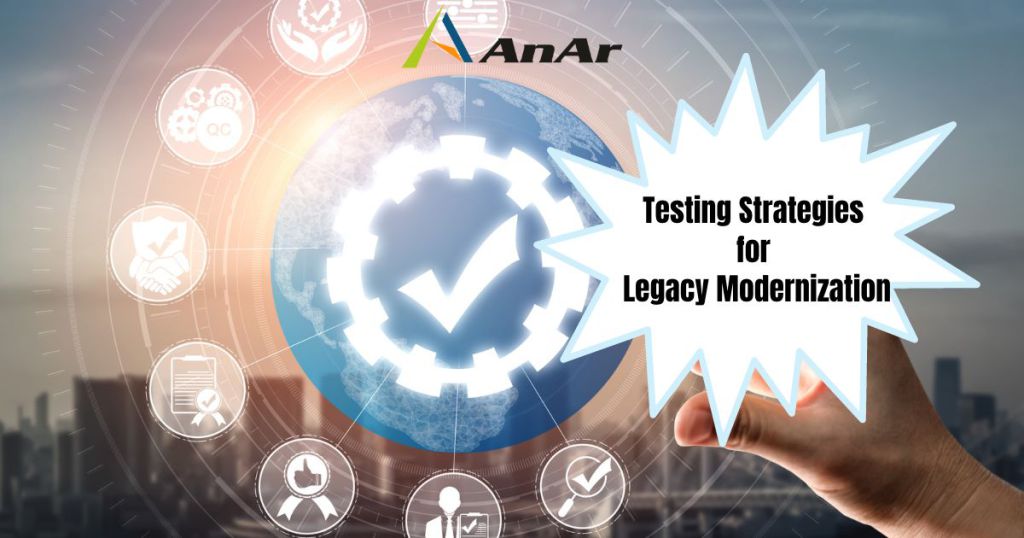Organizations across the globe are increasingly turning to legacy modernization to keep pace with rapidly evolving business needs and stay ahead of competitors. However, modernizing legacy systems is a complex process that requires careful planning, development, and testing.
While development teams typically receive the lion’s share of attention, unfortunately, quality assurance or testing teams (QAs) are often overlooked in legacy modernization projects, even though they play a critical role in ensuring success.
In this blog, we will learn about some of the most effective testing strategies for legacy modernization and how QAs can contribute to these strategies to deliver high-quality, performant, and valuable software.
What are most effective TESTING STRATEGIES FOR LEGACY MODERNIZATION, and how can Quality Analysts (QAs) contribute to these strategies?
Based on our experience in handling legacy modernization projects for clients worldwide, we have identified several modernization strategies through which Quality Analysts (QAs) or test engineers can contribute to the success of such initiatives.
Conducting a thorough Analysis, Comprehending, and Drawing Comparisons
To effectively test software, it is crucial for QAs to have a comprehensive understanding of the organization’s operations, including studying how the business has functioned in recent years and its perspective on customers and users, enabling QAs to test from the user’s viewpoint.
Next, QAs should conduct a comparative analysis to ensure that the modernized software provides the same level of functional depth and business value as the legacy system. This analysis should be included in the test validation/verification strategy, covering important areas like user experience, backend data population, user-friendliness, and business calculation logic.
By incorporating these comparisons, QAs can establish the necessary trust in the modernization project and its output, making adoption easier. This comparison helps lay the foundation for building trust in the project and ensures that the modernized software meets the end user’s needs and expectations.
Improving Software Performance
Organizations often modernize their technology to enhance performance, knowing that only when this is delivered will adoption improve. For instance, a company modernizes an e-commerce platform to improve its performance. Prior to modernization, the platform experienced frequent crashes during peak shopping periods, resulting in significant revenue loss. Implementing performance improvements such as optimized code, load testing, and server upgrades reduced the number of crashes by 90%, leading to a significant increase in revenue.
However, it’s not enough to simply implement these performance improvements. QA professionals play a crucial role in ensuring that these improvements are fostered and that performance metrics are published to encourage buy-in from the business teams.
By tracking performance metrics and sharing them with the business teams, QAs can demonstrate the effectiveness of the modernization initiative and show how it benefits the organization. In turn, this can help drive the adoption of the modernized system and lead to improved business outcomes.
Adding value through continuous Improvement and building trust
Legacy modernization involves more than simply replacing an outdated system. It’s also about continuously improving it to add value for users. While many stakeholders may be involved in such a project, quality assurance (QA) professionals should view value-add as their responsibility. As testers, they’re uniquely positioned to consider various ways products can be improved that might otherwise be missed.
To improve the system, QAs can identify user pain points and introduce features that eliminate mundane and repetitive tasks. They can also add helpers and auto-fills to make forms easier to use and introduce notifications about changes in the state of concerned items in the system. Furthermore, QAs can enhance the user experience by showing insights and calculations for faster decision-making and enabling easier access to frequently used references and documents. Additionally, introducing fraud identification and prevention measures can help protect the system and its users.
By continuously adding value in these ways, QAs can ensure that modernized systems not only meet user needs but also exceed expectations. This helps build trust in the system and encourages user adoption, ultimately leading to improved business outcomes.
Ensuring Integration Points with Contract Testing
Contract testing is important when integrating a new system with legacy subsystems. It involves defining expected interactions between the systems and verifying that they behave as expected. By running these tests with every commit, organizations can catch integration errors early in the development cycle and prevent costly problems downstream.
QAs can play a crucial role in contract testing by working with developers to define the contract and ensure that the tests are comprehensive. By actively participating in contract testing, QAs can help to ensure the reliability and stability of the system’s integration points. They can also help maintain and update the contract as the system evolves.
Facilitating Adoption with Before-and-After Testing
Legacy modernization can be a daunting process for businesses, and it’s crucial to have high adoption rates to ensure its success. QAs play a vital role in achieving this by driving adoption from the start. One method to do this is to prioritize the most used features during onboarding.
Before/after tests can be conducted, repeating specific functions in both the legacy and modern systems to identify gaps that might cause low adoption rates. The outcomes of these tests can be used to address any issues and improve the user experience.
Additionally, QAs should frequently communicate with users to understand their pain points and relay feedback to the development and business teams. By prioritizing users and constantly working to improve their experience, QAs can help drive higher adoption rates and ensure the success of legacy modernization projects.
Accelerate the Retirement of Subsystems
Legacy modernization projects aim to retire the legacy system as soon as possible, and QAs can play a crucial role in identifying subsystems that can be retired early on. QAs have a unique understanding of legacy systems, which allows them to pinpoint subsystems that can be easily retired and suggest prioritizing them. QAs can also play an active role in developing a roadmap for retiring legacy subsystems. By retiring subsystems more quickly and systematically, QAs can help organizations save on infrastructure costs.
Selecting the Appropriate Automation Framework
When it comes to choosing an automation framework, it is important to consider how it will support both legacy and modern systems. Unfortunately, many engineering teams overlook this crucial factor and end up with a framework that is unable to handle the legacy tech stack. This can create a difficult situation for QAs, who may be forced to write unreliable end-to-end tests. To avoid this issue, QAs should play an active role in selecting the automation framework.
Since legacy systems may have been functioning well for many years, QAs can also take steps to speed up the testing process. One useful technique is to stub the legacy system’s response as much as possible. This approach allows for faster tests by eliminating the need to wait for slow interactions that are common in many legacy systems. By making these smart choices in automation framework selection and test design, QAs can help ensure that legacy modernization efforts proceed smoothly and efficiently.
Aim for enablement as a byproduct.
When working on legacy tech stacks, client delivery teams may not have experience with the modernized application stack. This is where QAs can step in and assist by actively pairing with client teams to help them become familiar with the new system more quickly. In doing so, QAs can also facilitate enablement and training on early defect detection, as well as assist with tasks such as kickoffs and dev boxes. By striving for enablement as a byproduct, QAs can not only help clients become more proficient with the modernized system but also ensure that defects are caught early and that the project runs more smoothly overall.
Final Wrap-up
In conclusion, leveraging QA strategies is critical to the success of any legacy modernization project. By actively participating in the selection of automation frameworks, identifying subsystems that can be retired early, and continuously adding value through improvements and adoption, QAs can help ensure the smooth transition from the legacy system to the modernized one. Additionally, by facilitating enablement and training on early defect detection, kickoffs, and dev boxes, they can help client delivery teams become familiar with the modernized application’s stack faster. Together, these efforts can significantly increase legacy modernization’s effectiveness and set up organizations for long-term success.
Get in touch with us to understand how we have achieved a smooth legacy modernization for our Client.






